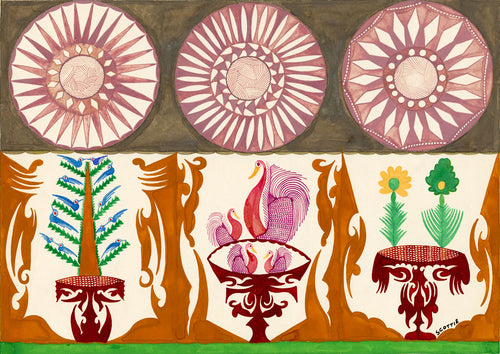Scottie Wilson’s discovery that he could draw was as much a surprise to him as it was to anyone. Picking up a bulldog pen in his second-hand store, he began to doodle one day on the top of a cardboard table. Within 48 hours the table was covered in tiny faces, flowers and stylised figures conjured purely from his imagination: The pen seemed to make me draw, and them images, the faces and designs just flowed out. I couldn’t stop – I’ve never stopped since...
 an 'Outsider Art' butterfly sketch, revealing Wilson's unusual eye for design
an 'Outsider Art' butterfly sketch, revealing Wilson's unusual eye for design
Born in Glasgow in 1891, Wilson left for Canada after serving in the Scottish Rifles. Though little is known about his life, it was here, aged around 40 years old, that he realised a passion for drawing, abandoning his job as a shopkeeper to make his trade as an artist. Intensely distrustful of dealers, he held few exhibitions, preferring instead to keep work for himself and display it in his own touring shows, charging nominal entrance fees. In 1945 he left Canada for London, just as galleries began to clamour for his work, and had drawings exhibited alongside Picasso, Klee, Mirò and de Chirico.
 a framed textile panel by Wilson, a limited number of which were recently acquired by Goldmark
a framed textile panel by Wilson, a limited number of which were recently acquired by Goldmark
Picasso and his contemporary Jean Dubuffet became great admirers of Wilson’s ‘outsider’ art, much of which they bought directly from the artist and at marginal cost. The critic Bill Hopkins, one of few establishment figures whom Wilson came to trust, once described a journey the pair undertook to visit Picasso and Dubuffet in France: Both owned a few of Scottie’s pieces, and Picasso had come to see – and perhaps buy – some more. I vividly remember both artists eagerly admiring Scottie’s work, squabbling in their fierce, theatrical, Gallic voices over who would buy which piece.
 one of a number of textile tapestry designs produced in collaboration with the Edinburgh Weavers
one of a number of textile tapestry designs produced in collaboration with the Edinburgh Weavers
These newly arrived printed cotton satin designs were one of a number of textile collaborations between Wilson and the distinguished Edinburgh Weavers. Founded in 1928 by James Morton, the Edinburgh workshop developed a worldwide reputation for its experimental approach to textile production, marketing its services to artists, designers, and advertising creatives alike. Throughout the 1940s and '50s they engaged in a number of cooperative projects under the visionary leadership of Alistair Morton until, after his death, the firm was subsumed by the mammoth fabric manufacturers Courtaulds in 1963.
 detail of the printed satin piece
detail of the printed satin piece
Produced as one of a number of textile and tapestry prints made with the Weavers across the mid 1950s, many of which are now housed in public collections such as the V&A, these cotton panels reveal Wilson’s fondness for line and decoration: birds perch on flowers like avian leaves and petals, merging with stalks, vines, and repeated geometric motifs, all printed in the luscious reds, purples and yellows achieved in the Edinburgh studio. The result is a delightful satin menagerie, an aviary of lines, colours and curves that make for a wonderful curio of art and design history.










